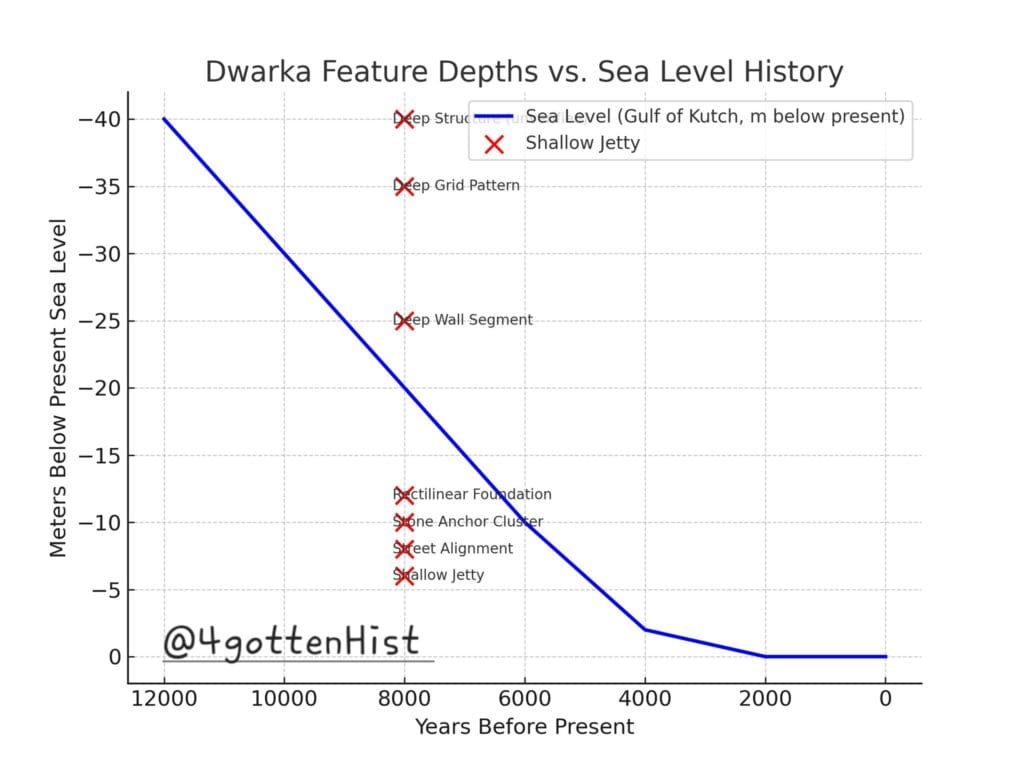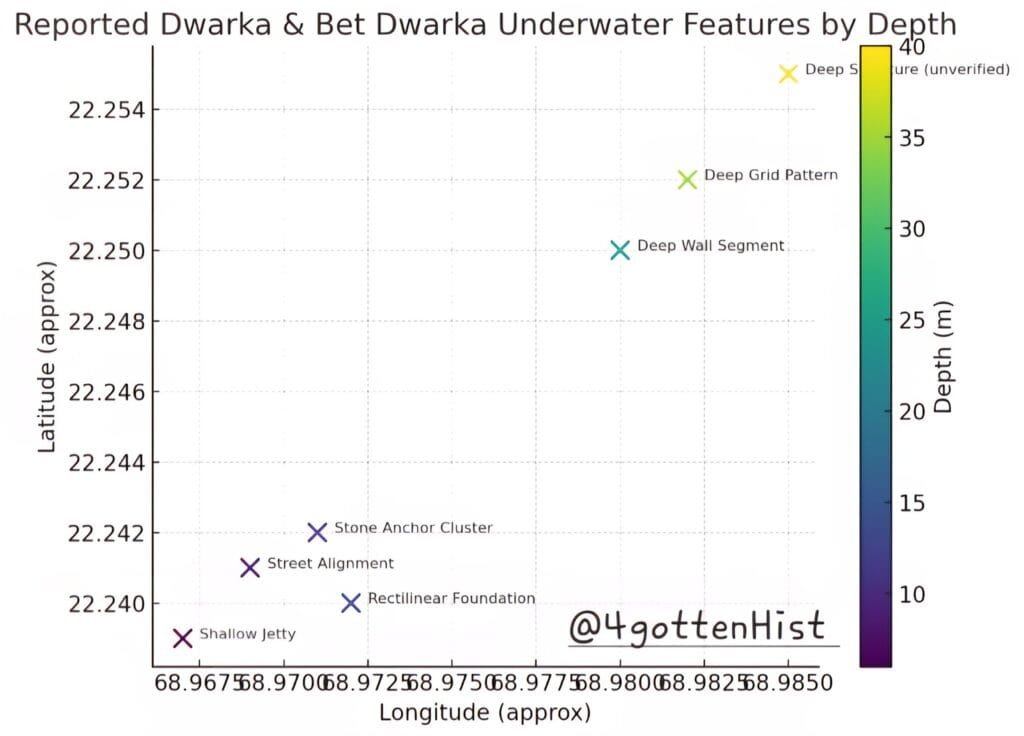I investigate ancient sites because I believe they often hold more than one story. The Dwarka underwater city in Gujarat, India, sits at the heart of one of the most important historical debates I have ever studied.
When I dove into the records, I expected to find just another Harappan port site with some romantic mythology attached. What I found instead is a depth problem that forces us to question the official dating entirely of the dwarka underwater city
Starting with the Mainstream Story

Archaeologists working for the Archaeological Survey of India and the National Institute of Ocean Technology have surveyed the waters off modern Dwarka and Bet dwarka island. They mapped submerged walls, streets, mooring stones, and jetty-like structures.
The mainstream view assigns these features to the Harappan or post-Harappan period, around 2600–1500 BCE. In this narrative, Dwarka functioned as a busy Bronze Age port before it eventually succumbed to coastal erosion and the sea.
On the surface, that timeline seems logical. But as soon as I started comparing reported depths with sea-level history, the Harappan dating stopped making sense.
When the Depth Tells a Different Story
I compiled depth reports from NIOT surveys, diver logs, and scattered references in marine archaeology literature. These sources describe anomalies at a range of depths — some shallow, between 4 and 12 meters, but others much deeper, between 20 and 40 meters below present mean sea level.
If we want to test the Harappan claim, we must compare these depths to the actual sea-level record for the Gulf of Kutch. That’s when the entire picture changes.
- Around 4000 BCE, sea level stood within 2 meters of today’s.
- Around 6000–7000 BCE, sea level stood about 20 meters lower.
- Around 9000 BCE, sea level stood about 40 meters lower.
The last time any location in the Gulf of Kutch stood 20–40 meters above water was during the early Holocene, at the tail end of the Ice Age. If the deeper features are man-made, they could not have been built in Harappan times — they would have been underwater for thousands of years before that.
Visual Evidence: Sea-Level Curve vs. Dwarka Depths

Caption: Overlay of Dwarka’s reported feature depths against the Gulf of Kutch sea-level curve. The Harappan period falls long after the deeper sites would have submerged.
This graph shows why the “depth problem” matters. The red points represent reported Dwarka features at various depths. The blue curve represents the established sea-level history for the region. Anything below 10 meters today would have already been underwater before 4000 BCE. The deeper finds at 25–40 meters would have been lost to the sea between 6000 and 9000 BCE.
Mapping the Features of Dwarka Underwater City.
To organize the data, I plotted the reported sites on a location map with their depths.

Caption: Approximate locations of reported Dwarka and Bet Dwarka underwater features, color-coded by depth.
The map shows a clear separation between the shallow, well-documented Harappan-era finds and the much deeper anomalies. The shallow finds include jetty-like structures, stone anchors, and rectilinear foundations close to shore. The deeper anomalies include grid-like patterns and wall segments far below the range of Harappan sea levels.
Why This Matters to My Research of Dwarka Underwater City
I do not approach this as someone trying to “prove” a myth. I follow the evidence wherever it leads. In this case, the depth evidence does not align with the official dating. The data forces me to consider an earlier origin.
If these deeper structures are artificial, they must predate the Harappan civilization by several millennia. That would place them in the early Holocene — a period of rapid post-Ice Age sea-level rise that drowned coastal settlements all over the world.
Global Parallels
Other submerged sites show similar patterns:
- Yonaguni, Japan: Controversial stepped formations possibly dating to before 10,000 BCE.
- Pavlopetri, Greece: Proven submerged city ~5000 BCE.
- Bimini Road, Bahamas: Debated; possible Ice Age maritime site.
Dwarka fits this pattern — a potential pre-Holocene coastal settlement buried beneath meters of water during global meltwater pulses.
Dwarka Underwater City: Myth and Memory

In the Mahabharata, Dwarka was a golden city founded by Lord Krishna. After his death, the text says, the sea reclaimed it entirely. Many treat this as metaphor or moral allegory. But oral traditions often encode real environmental events.
Aboriginal Australian myths describe coastlines that last existed over 7,000 years ago. Pacific island legends recall vanished islands and shorelines from the same period. Dwarka’s legend may be another preserved memory of Ice Age flooding.
Artifacts and Gaps
Stone anchors and pottery fragments from the shallow sites match known Harappan designs. These finds make sense for a Bronze Age port — but they tell us nothing about the deeper sites.
We have no published radiocarbon dates for the deepest anomalies. No formal excavations have brought up datable organic material from those depths. This gap matters because it keeps the older origin theory in the realm of possibility.
Direct Comparison of Narratives
When you lay the two narratives side by side, the difference becomes clear. The mainstream model explains the shallow finds but ignores or dismisses the deeper anomalies. The alternative model explains both — but requires us to accept the possibility of organized coastal settlement thousands of years earlier than currently acknowledged.
What Needs to Happen Next
For me, the next step in this research is clear:
- Obtain precise coordinates and sonar data for the deepest anomalies.
- Wait for planned excavations to be done and see if organic material from the deeper site is gathered.
Without this, the debate will remain open, and the official story will keep ignoring the depth problem.
Conclusion for Dwarka Underwater City depth problem.
My research into Dwarka started as an investigation into a Harappan port. It has become a case study in how hard data — in this case, depth and sea-level history — can overturn accepted narratives.
I cannot yet prove the deeper sites are man-made. But if they are, the Harappan date is impossible. These structures would belong to the early Holocene, possibly as far back as 9000 BCE.
That changes everything we think we know about the origins of coastal civilization in India.
Pingback: Dwarka’s Depth problem that links it to Atlantis